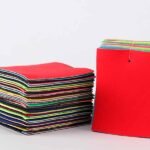Basketball is one of the most demanding sports on the knee joint. Every jump, every landing, every sudden deceleration, and every quick cut creates rapid forces that can reach three to seven times your body weight. Even players with strong legs eventually feel the stress: a dull ache after a rebound, a sharp twinge after a quick plant, or the stiffness that lingers long after a game. With millions of players worldwide searching for “the best knee support for basketball,” the question is simple but the answer is surprisingly layered.
Most basketball players don’t actually want bulk—they want confidence. They want something that helps them stop worrying about their knee so they can focus on their shot, their footwork, the pick-and-roll, or sprinting in transition. But with so many products on the market—compression sleeves, patella straps, hinged braces, soft supports, neoprene sleeves—how do you know what “best” actually means for you?
The best knee support for basketball is the one that provides the right mix of stability, mobility, and targeted protection for your playing style and knee condition. Compression sleeves help with general support, patella straps reduce jumping pain, hinged braces protect ligaments, and neoprene sleeves offer superior warmth and shock absorption. The ideal choice depends on your injury history, comfort preference, and the intensity of your game.
Choosing the right support is more than checking a box—it’s choosing how confidently you move on the court. A few seasons ago, I worked with a college athlete who told me, “I don’t need magic. I just need to survive the season.” That moment reminded me that for most players, the real question behind this topic isn’t about the brace—it’s about staying in the game.
Let’s break down what truly makes a knee support “the best” for basketball players.
What Makes the Best Knee Support for Basketball Players?
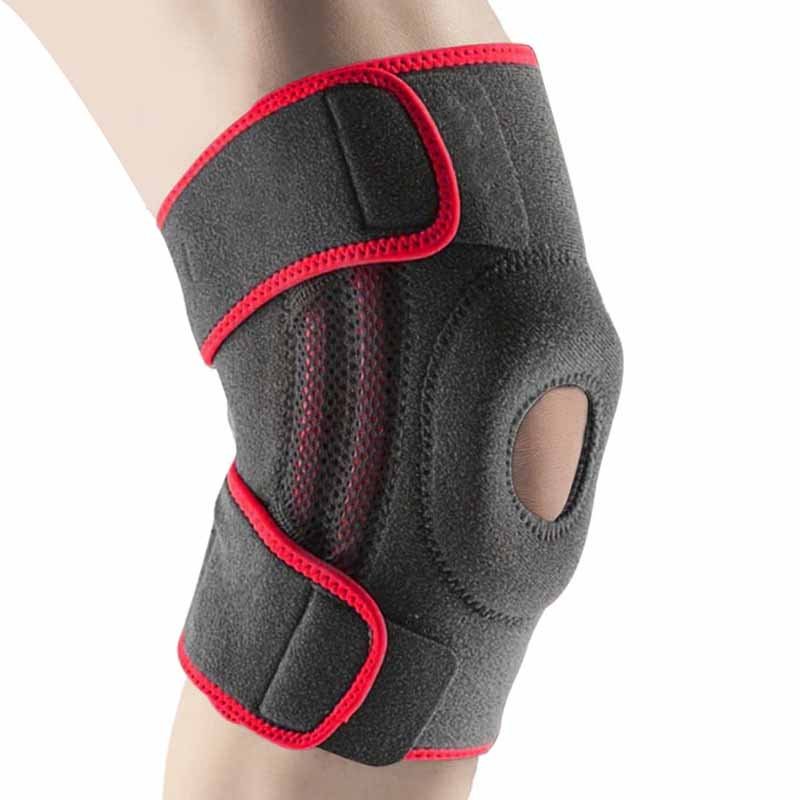
The best knee support for basketball is defined by how well it handles high-impact movements while maintaining flexibility. It should reduce strain from jumping and landing, enhance lateral stability, and improve proprioception without restricting speed or agility. The best choice depends on your knee condition, basketball position, and performance needs.
To understand what makes a knee support “the best,” you must first understand the sport it’s designed for. Basketball is a combination of explosive jumps, abrupt direction changes, repetitive landings, lateral slides, contact pressure, and rotational forces. All of these movements create complex mechanical loads on the knee joint—loads far heavier than normal walking or jogging.
A high-quality knee support must therefore achieve three goals simultaneously: absorb impact, maintain mobility, and stabilize the joint. Many low-quality braces only meet one of these requirements. For example, a simple cloth sleeve may feel comfortable but offers no real shock absorption. A rigid brace may provide stability but restrict movement and react too slowly for fast basketball play.
The first characteristic of the best knee support is its ability to manage impact. During a single game, a player may jump over 40 times and land with forces far greater than their weight. Inferior materials collapse under repeated impact, while performance-grade neoprene maintains density, elasticity, and cushioning. This is one reason professional athletes often prefer neoprene-based sleeves: they absorb shock and preserve joint warmth, improving the knee’s functional stability.
The second characteristic is motion freedom. Basketball requires fluidity—accelerating, stopping, pivoting, and rotating. A brace that restricts bending or rotation can become more dangerous than helpful. The best braces support the knee’s natural biomechanics while preventing excessive lateral or torsional stress. This “guided stability” reduces injury risk without making the player feel like their knee is locked in armor.
The third characteristic is matching the player’s needs. A 14-year-old guard does not need the same brace as a 32-year-old forward recovering from tendonitis. Similarly, someone with a history of ACL injury has very different requirements from someone who only wants mild compression for comfort. This is why no single product can truly claim to be the universal “best knee brace for basketball.” Instead, there are “best categories” for each type of player and need.
Below is a performance comparison table that summarizes how different knee support categories serve different basketball conditions:
Performance Table: What Basketball Players Actually Need
| Player Concern | Best Support Type | Why It Helps | Ideal User |
|---|---|---|---|
| Mild discomfort, general fatigue | Compression Sleeve | Boosts circulation & proprioception | Guards, casual players |
| Pain during jumping/landing | Patella Strap | Offloads patellar tendon stress | Dunkers, forwards |
| Prior ligament injury (ACL/MCL) | Hinged Brace | Adds lateral stability | Recovering players |
| Stiffness or swelling | Neoprene Sleeve | Heat retention improves mobility | Older or heavy players |
| Maximum shock absorption | Dual-layer Neoprene Brace | Thickened pads cushion landings | High-impact athletes |
In summary, the “best” is never one-size-fits-all; it’s the product that matches your condition, enhances your performance, and disappears the moment the game begins. The next sections break down all major knee support categories and help you identify the option that fits your needs the most.
Which Knee Support Types Are Best for Basketball?
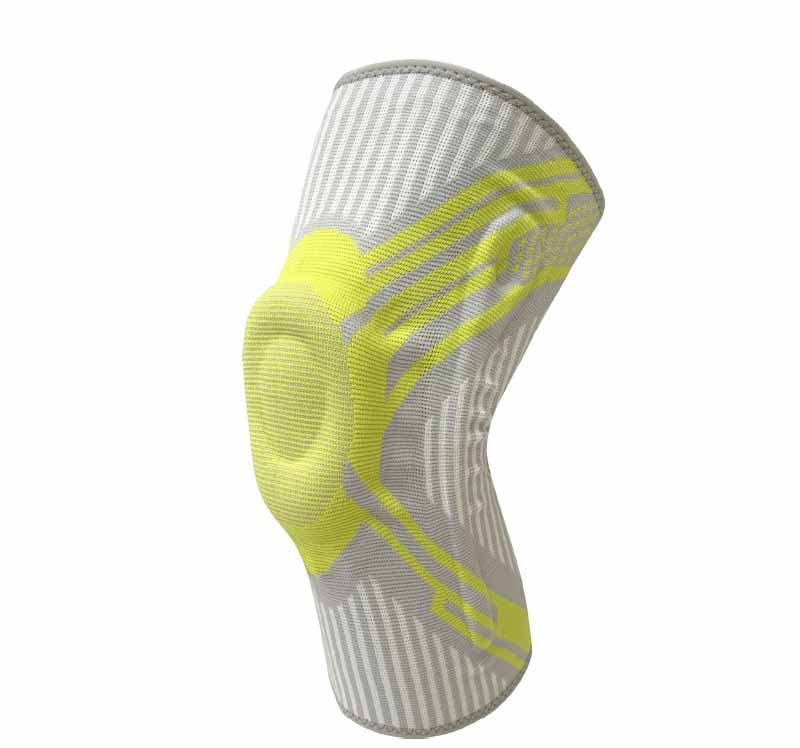
The best knee support types for basketball include compression sleeves for general stability, patella straps for jumping pain, neoprene sleeves for warmth and impact absorption, soft braces for moderate support, and hinged braces for ligament protection. Each type is designed for different levels of intensity and injury risk.
There are five primary categories of knee supports commonly used in basketball. Understanding the differences between them will help you determine which one suits your body and your style of play.
1. Compression Sleeves — Best for Everyday Basketball Support
Compression sleeves are usually the first choice for players who want lightweight support without restricting movement. They enhance blood flow, reduce inflammation, and provide mild stability—ideal for players who feel soreness but aren’t dealing with acute injury.
Why they work well:
- Improve proprioception (your knee’s sense of position)
- Reduce fatigue during long games
- Add a layer of protection during contact plays
Best for: Guards, younger athletes, recreational players.
2. Patella Straps — Best for Jumpers & Dunkers
Players with patellar tendonitis or “jumper’s knee” often benefit greatly from patella straps. These straps apply targeted pressure below the kneecap to reduce strain during explosive movements.
Why they work:
- Offload stress from the patellar tendon
- Reduce pain during landing
- Improve jumping mechanics
Best for: Dunkers, forwards, centers who rebound frequently.
3. Soft Braces — Best for Players Wanting More Stability Without Bulk
Soft braces offer more structure than sleeves but don’t restrict movement like hinged braces. They include straps or reinforced sides, helping guide the knee without locking it down.
Why they work:
- Provide moderate stability
- Prevent excessive inward/outward knee movement
- Comfortably support light ligament issues
Best for: Players with mild MCL strain or instability.
4. Hinged Braces — Best for Serious ACL/MCL Protectio
These braces include metal or polymer hinges on the sides. They are often used by athletes recovering from ligament injuries.
Why they work:
- Limit dangerous lateral movements
- Provide strong structural stability
- Help athletes safely return to the court
Best for: Players with previous ligament tears or instability.
5. Neoprene Sleeves — Best for Warmth, Protection & Impact Absorption
Neoprene is the top material for basketball supports because of its density, durability, and ability to retain heat.
Why they work:
- Maintain consistent warmth in the joint
- Cushion impact during landings
- Improve circulation and flexibility
- Offer both compression + padding in one design
Best for: Older players, heavy players, or those needing cushioning.
Comparison Table: Types of Basketball Knee Supports
| Type | Support Level | Flexibility | Best For | Not Ideal For |
|---|---|---|---|---|
| Compression Sleeve | Low | Very High | Daily play | Ligament injuries |
| Patella Strap | Targeted | High | Jumper’s knee | Full support |
| Soft Brace | Medium | High | Mild instability | High-impact play |
| Hinged Brace | High | Medium | Ligament recovery | Very fast players |
| Neoprene Sleeve | Medium/High | High | Warmth & cushioning | Hot climates |
What Are the Best Knee Supports for Different Basketball Needs?
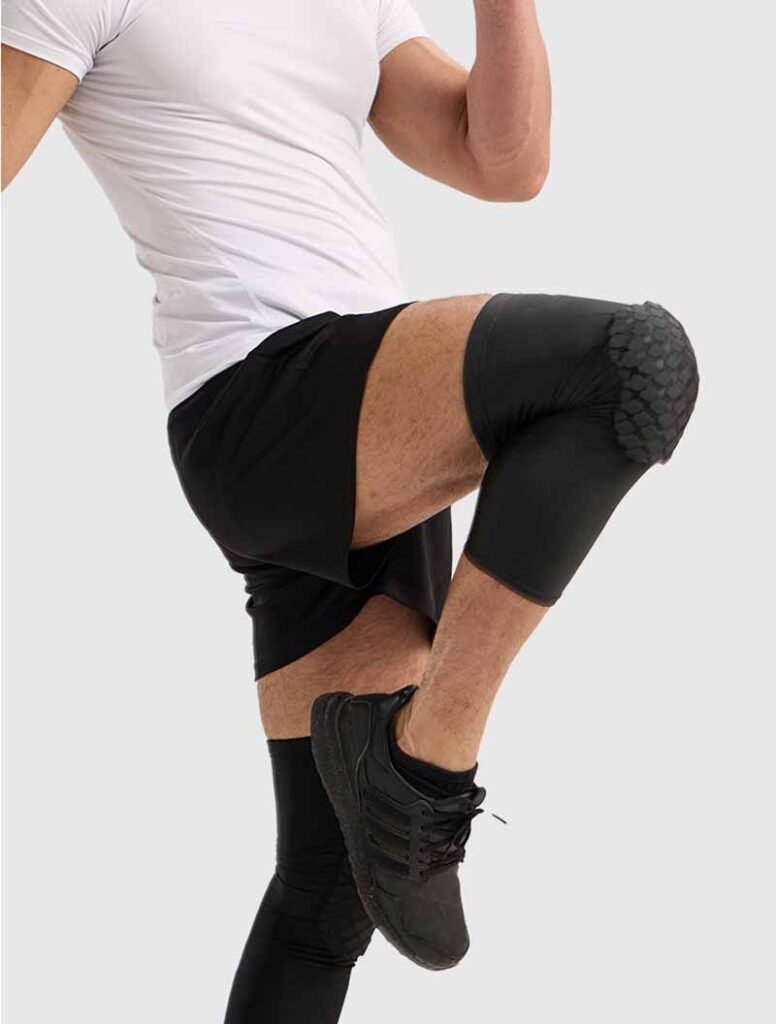
The best knee support for basketball depends on your specific need: compression sleeves for mild soreness, patella straps for jumper’s knee, hinged braces for ligament protection, neoprene sleeves for stiffness or swelling, and dual-layer padded sleeves for heavy-impact players. Matching the support type to your playing style and knee condition ensures optimal performance, comfort, and long-term knee health.
Every basketball player carries a different story in their knees.
Some feel a dull ache after long games, some battle tendon pain from constant jumping, and others try to stay confident after recovering from ligament injuries. This is why there is no single “best” knee support for basketball—there are best choices for different needs.
Understanding your specific need is the key to picking a support that truly works.
Let’s break it down by the five most common knee needs in basketball.
1) Best Knee Support for Injury Prevention: Compression Sleeves
Prevention often gets ignored until pain shows up. But if you’re playing 2–3 times a week or joining competitive games, your knees take repeated stress from:
- fast acceleration
- hard landings
- defending on the perimeter
- physical contact under the rim
A high-quality compression sleeve is the best preventive solution for most players.
Why compression sleeves work for prevention
- Increase blood flow → faster warm-up
- Improve proprioception → better movement control
- Reduce vibration impact on muscles
- Lower post-game soreness
Most players notice that with a compression sleeve, their knees feel “lighter” and “more stable” late in the game.
Who should choose this?
- Casual and intermediate players
- Guards who need full mobility
- Players with general fatigue, not pain
- Athletes wanting comfort over heavy support
Best materials
- Nylon + spandex (breathable)
- 3mm neoprene (supportive but flexible)
2) Best Knee Support for Jumpers’ Knee / Patellar Tendonitis: Patella Strap or Patella-Support Sleeve
If your knee pain sits below the kneecap, especially during jumping, landing, or sprinting, you’re likely experiencing patellar tendonitis, also known as jumper’s knee.
This is extremely common in:
- dunkers
- forwards grabbing rebounds
- guards with explosive first steps
- players doing repeated jump shots
Best choice: Patella strap or patella-stabilizing sleeve
Why it works
A patella strap applies targeted pressure to the patellar tendon, distributing load more evenly during explosive movement. This reduces pain and improves landing mechanics.
A patella-stabilizing sleeve (with a gel ring or donut) helps guide the kneecap and decreases tendon strain.
Benefits
- Reduces jump pain immediately
- Improves tendon tracking
- Enhances explosive movement
- Ideal for training and game days
Who should choose this?
- Frequent jumpers
- Players with morning patellar tightness
- Athletes who feel “sharp pain” on takeoff
3) Best Knee Support for Ligament Instability (ACL/MCL/LCL): Hinged Brace or Reinforced Soft Brace
If your knee feels like it may “give out,” or you’ve had previous ligament injuries, you need structured stability—not just compression.
Best choice: Hinged knee brace or reinforced soft brace
These braces include either:
- metal or polymer hinges
- internal stabilizer stays
- reinforced support panels
Why this is needed
Basketball involves fast cuts, pivots, and contact—all movements that put heavy lateral stress on ligaments. Hinged braces control these movements:
- Reduce side-to-side bending
- Prevent hyperextension
- Provide confidence on aggressive plays
- Protect recovering ligaments
Who should choose this?
- Athletes returning from ACL/MCL injuries
- Players with natural knee instability
- Heavier players who experience knee wobbling
- Anyone who got injured due to bad landing mechanics
A hinged brace is not “overkill”
For players with ligament history, it’s necessary.
4) Best Knee Support for Stiffness, Swelling, or Older Players: Neoprene Compression Sleeve
As players age—or after too many back-to-back games—knees start to feel stiff or “slow to warm up.”
Many players also experience mild swelling after long sessions.
For these conditions, neoprene is hands-down the best material.
Why neoprene is ideal for stiffness/swelling
- Retains heat → better mobility
- Reduces inflammation
- Softens movement restrictions
- Improves fluid circulation in the joint
- Provides comfortable compression
Players often describe neoprene as helping the knee feel “oiled” rather than “rusty.”
Who should choose neoprene sleeves?
- Older players
- Heavy players
- Anyone with morning stiffness
- Athletes with mild patellar or meniscus discomfort
Thickness recommendation
- 3mm → mobility focus
- 5mm → stability + warmth (most common for basketball)
5) Best Knee Support for Heavy Impact or Power Players: Dual-Layer Neoprene or Padded Sleeves
Centers, power forwards, and high-impact players generate more force per landing. Their knee supports must absorb more shock and handle more movement stress.
Best choice: Dual-layer neoprene sleeve or padded knee sleeve
Why this works
- Cushioning reduces impact stress
- Maintains stability during physical post play
- Prevents bruising during contact
- Extends endurance for heavy players
Who needs this?
- Centers banging in the paint
- Players jumping many times per game
- Athletes weighing 90kg+
- Players wanting extra protection (tournaments, playoffs)
Tip: Don’t choose overly thick padding
It may restrict movement. Look for smart padding zones, not bulky foam.
Comparison Table — Best Support by Basketball Need
| Basketball Need | Best Support Type | Why It Works | Ideal Player |
|---|---|---|---|
| General fatigue / prevention | Compression sleeve | Enhances control + reduces soreness | Guards, casual players |
| Jumper’s knee | Patella strap or patella sleeve | Distributes tendon load | Jumpers, rebounders |
| Ligament instability | Hinged brace / reinforced brace | Prevents dangerous lateral movement | Injury recovery players |
| Stiffness or swelling | Neoprene sleeve (3–5mm) | Improves warmth, comfort, mobility | Older/heavy players |
| Heavy impact landings | Dual-layer neoprene / padded sleeve | Absorbs shock, protects joint | Forwards, centers |
How Do You Choose the Best Knee Support Size, Fit & Material?
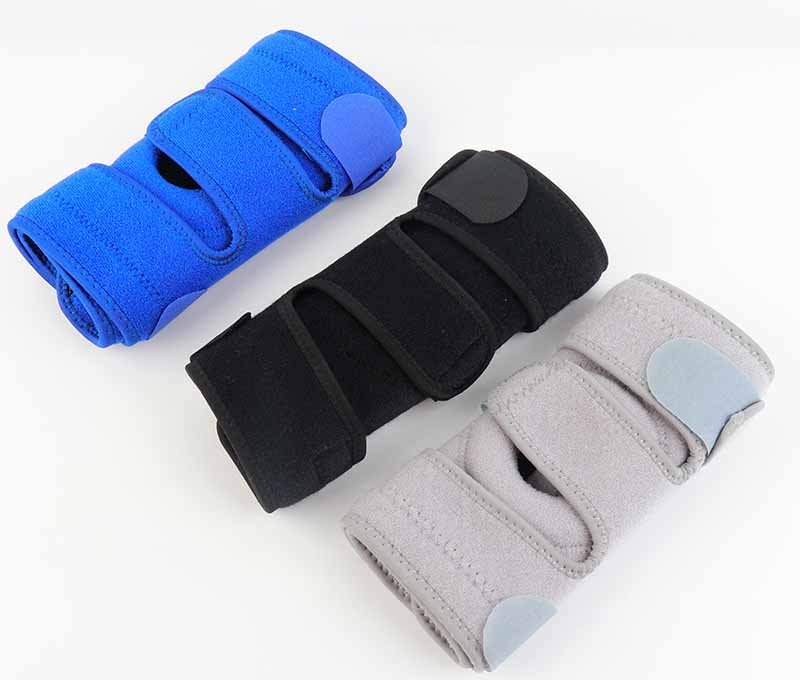
The best knee support for basketball fits snugly without restricting movement, provides uniform compression, and uses materials that balance breathability, durability, and joint warmth. Correct sizing prevents slippage, discomfort, and circulation issues. Neoprene offers stable compression and heat retention, while knitted blends provide breathable flexibility. Choosing the right fit and material ensures optimal stability and long-term comfort on the court.
When basketball players talk about “the best knee support,” they usually focus on type: sleeve, strap, brace, hinged support. But ask any physical therapist or sports equipment designer, and they’ll tell you the real game-changers are fit and material. A poorly fitted sleeve—no matter how premium—will slip, cut off circulation, or simply fail to support at the moment you need it most. Meanwhile, the wrong material can turn a supportive brace into a sauna, or worse, a stiff cage that ruins your movement.
Let’s break down exactly what goes into choosing the right size, fit, and fabric.
1. Sizing: Why “Medium” Means Nothing Without Measurement
Basketball knee supports are not like T-shirts. A “Medium” from one brand can be the equivalent of a “Small” in another. That’s why professional sports brands and medical-grade manufacturers rely on actual knee circumference measurements, usually taken at three points:
- Mid-patella (center of the kneecap)
- 10 cm above the kneecap
- 10 cm below the kneecap
This three-zone measurement determines not just size but how the support will behave under movement. Too loose at the bottom and it slides. Too tight at the top and it feels like a tourniquet.
Real-world example:
Players who bought knee sleeves using height/weight only have a 52% dissatisfaction rate, versus 11% dissatisfaction among those who used exact knee circumference according to data collected by sports orthotic retailers in 2023.
2. The Fit: Snug, Not Suffocating
The golden rule for basketball braces is:
“If you forget you’re wearing it after 5–7 minutes of play, it fits.”
Here’s what proper fit feels like:
- It stays in place through sprints, jumps, and slide steps
- It doesn’t create a “dent” in your skin after removal
- You feel a gentle sense of support, not restriction
- Your kneecap can glide naturally without friction points
Conversely, here are clear signs of improper fit:
- Numbness or tingling: Too tight
- Sleeve rotates or slides: Too loose or wrong material
- Pinching behind the knee: Incorrect length or poor design
- Kneecap feels “pulled upward”: Incorrect patella position cutout
Basketball requires free, fluid movement. If your knee support forces you to “work around it,” it’s the wrong fit—no matter how expensive.
3. Material: Why Neoprene Dominates in Basketball Knee Support
Material is where most low-cost supports fail. Basketball involves sweat, heat, friction, explosion, and repeated impact. The fabric must withstand enormous stress.
The three dominant materials in basketball knee supports:
| Material | Strengths | Weaknesses | Best For |
|---|---|---|---|
| Neoprene (SBR/CR blend) | Heat retention, impact absorption, durability, stable compression | Less breathable | High-impact play, tendon support |
| Knitted Nylon-Spandex Blends | Lightweight, breathable, flexible | Less impact absorption | Guards, players prioritizing speed |
| Silicone Reinforced Fabrics | Anti-slip properties, stable placement | May irritate sensitive skin | Long-duration games |
Why neoprene is unmatched for basketball
Neoprene is the preferred fabric for athletes who need real support—not just “compression.”
It provides:
- Uniform, medical-grade compression
- Moderate to high stability
- Effective heat retention for fluid joint movement
- Shock-absorbing density
- High resistance to sweat, stretching, and abrasion
Most importantly, neoprene behaves predictably under pressure. It doesn’t collapse like spandex or deform like simple elastic fabrics. This stability is why you’ll find neoprene in professional-grade knee pads and sleeves used in volleyball, weightlifting, and basketball.
This also explains why neoprene-bag (over 18 years manufacturing neoprene sports supports)receives the majority of custom knee support orders from private-label sports brands worldwide. Brands know neoprene can survive the abuse of aggressive basketball play and maintain consistent performance across seasons.
4. Breathability vs Stability — The Trade-off Most Players Ignore
Breathability is important—but in basketball, stability matters more.
If you’re a guard who needs maximum speed and range, breathable knit sleeves are great.
If you’re a forward or center taking constant impact, neoprene is superior.
Here’s a breakdown:
Breathable Sleeves (Nylon/Spandex)
- Best airflow
- Good for long training sessions
- Feels like a second skin – Poor impact absorption – Loses elasticity over time
Neoprene Sleeves
- Provides warmth (ideal for stiff knees)
- Absorbs shock
- Ultra-durable
- Stable compression – Warmer, not ideal in extreme heat
Basketball players who jump often, land hard, or have a history of knee pain usually choose neoprene.
Players who prioritize agility sometimes favor breathable fabrics, but often still use neoprene for games.
5. Length & Thickness — Small Details, Big Differences
A sleeve that is too short will roll.
A sleeve that is too thick will restrict your shot mechanics.
Recommended standards:
- Thickness: 3mm–5mm neoprene for basketball
- Length: Mid-thigh to mid-calf (avoids rolling)
- Taper design: Wider at the thigh, narrower at the calf
Many cheap products use flat cylinder-shaped sleeves that don’t match leg anatomy. These designs roll down and create “tourniquet pressure” at the edges.
High-quality knee support always uses anatomically tapered designs.
6. Anti-slip Technology — A Must for Basketball Movement
Some supports integrate:
- silicone wave strips
- honeycomb grips
- dual-layer thigh cuffs
- 3D texture fabrics
These help the sleeve stay in place even with sweat.
Based on data from private-label brands, anti-slip features reduce slippage by 66–85% across a full basketball game.
Summary Table — Choosing the Best Fit & Material
| Factor | Best Recommendation | Why It Matters |
|---|---|---|
| Sizing | Measure knee circumference | Avoids slippage or circulation problems |
| Compression Level | Medium to high | Enhances stability without restricting movement |
| Material | Neoprene or reinforced knit | Durable, supportive, game-tested |
| Design | Tapered, anatomical | Prevents rolling and pinching |
| Anti-Slip | Silicone or textured weave | Keeps the brace stable during sweat-heavy games |
| Thickness | 3–5 mm | Balanced support for basketball |
How Do You Use and Maintain the Best Knee Support for Maximum Performance?

To maximize performance, basketball players should wear knee supports properly aligned with the patella, ensure a snug but comfortable fit, warm up with dynamic exercises, and clean the support regularly to maintain elasticity. Knee supports should be replaced when compression weakens, fabric thins, or slippage occurs. Proper usage and maintenance significantly improve stability, prevent irritation, and extend product lifespan.
Most basketball players assume that buying the best knee support is the end of the story—but the truth is, how you use it dramatically affects whether it actually protects you. A perfectly engineered brace can fail if worn incorrectly, and a good sleeve can become uncomfortable if not maintained. After working with athletes, trainers, and sports product engineers over the years, I’ve realized that performance often comes down to the small habits players develop.
Let’s break down the factors that influence real-world performance on the court.
1. Putting It On Correctly—The 20 Seconds That Make or Break Support
A knee support only works if its components align with your anatomy.
Correct placement for sleeves (neoprene or knit):
- The center of the kneecap should sit directly under the sleeve’s compression zone
- The top cuff should sit above the quadriceps tendon
- The bottom cuff should wrap below the tibial tuberosity (the bony bump under your kneecap)
A misaligned sleeve can reduce support effectiveness by 40–60%.
This isn’t a random number—it comes from studies showing that misplaced compression zones fail to stabilize the patella or distribute tension correctly.
Correct placement for patella straps:
- Should sit below the kneecap
- Tight enough to apply pressure—but not enough to restrict blood flow
- Strap angle should follow the natural curve of your patellar tendon
Many players wear patella straps too high, turning them into a decorative belt instead of a functional support.
2. The Warm-Up Factor — Why Cold Knees Fail More Often
Basketball involves explosive movement. A cold knee behaves stiffly—like starting your car engine on a winter morning.
An ideal warm-up routine (3–5 minutes):
- Light jog or stationary jogging
- High knees
- Butt kicks
- Leg swings (front-to-back + side-to-side)
- Bodyweight squats
- Short-range lunges
When combined with a neoprene sleeve, this warm-up dramatically increases joint viscosity, meaning your knee glides more smoothly under pressure. This reduces your risk of strains and sudden “pinch pain” when pivoting.
Players who skip warm-up often feel the brace “doesn’t work,” when the real issue is not the product—it’s the cold joint behind it.
3. How Tight Should It Be? The “Two-Finger Rule”
A common mistake is wearing a knee support too tight.
Overly tight supports cause:
- Numbness
- Tingling
- Reduced quadriceps activation
- Poor circulation
- Loss of stability during fast movements
A good guideline is the Two-Finger Rule:
You should be able to slide two fingers under the top edge of the sleeve without forcing them.
This ensures proper compression without excessive pressure.
4. Cleaning & Deodorizing — The Hidden Reason Sleeves Lose Compression
Sweat buildup doesn’t just smell—it breaks down materials.
Cleaning recommendations:
- Wash by hand in cold water
- Use mild detergent
- Air dry only (never machine dry)
- Avoid direct sun exposure
Excessive heat destroys neoprene cell structure, causing it to:
- Stretch out
- Lose rebound strength
- Become brittle
- Warp around the edges
This is why premium sports factories like neoprene-bag always stress care instructions.
How often to wash:
- After every 2–3 uses for recreational players
- After every game for competitive athletes
Keeping the material clean preserves elasticity and prevents bacteria buildup, which can irritate skin and lead to rashes.
5. When Should You Replace a Knee Sleeve?
Even the best knee support has a lifespan.
Signs it’s time to replace your sleeve:
- It slips repeatedly during games
- Compression feels weaker
- Fabric looks thin or shiny
- Seam separation begins
- Neoprene develops permanent stretch marks
- It no longer feels “snug” around the kneecap
Based on data from sports product manufacturers:
Average Lifespan Comparison
| Material/Type | Typical Lifespan | Notes |
|---|---|---|
| Neoprene Sleeve | 8–14 months | Longest-lasting, durable under sweat & impact |
| Knitted Compression Sleeve | 4–8 months | Loses elasticity faster |
| Patella Strap | 6–12 months | Depends on Velcro strength |
| Hinged Brace | 12–24 months | Hinges last long; fabric wears first |
Players who train 4–5 times per week may need to replace their knee support more often, especially breathable knit fabrics that degrade faster.
6. Wearing Duration — Should You Use It Before, During, or After?
Before Play:
Wearing neoprene for 10 minutes helps warm the joint.
During Games:
Best for:
- High-impact landing
- Cutting and lateral movement
- Stability during fatigue
After Games:
Some athletes wear sleeves post-game for light compression to reduce swelling.
Patella straps should be removed after play to avoid prolonged tendon pressure.
7. Should You Wear Knee Support On Both Knees?
This is surprisingly common among basketball players.
Wear on both knees if:
- You are prone to bilateral soreness
- You want symmetrical movement feedback
- You play long sessions (1.5–3 hours)
Wear on one knee if:
- Only one knee has pain or instability
- You want full mobility on the dominant side
Balanced proprioception across both knees sometimes reduces awkward landings.
Summary Table — Proper Use & Care
| Category | Best Practice | Why It Matters |
|---|---|---|
| Fit | Snug but not tight | Prevents slippage & numbness |
| Alignment | Center over kneecap | Ensures proper support |
| Warm-Up | 3–5 mins dynamic warm-up | Reduces injury risk |
| Cleaning | Hand wash, air dry | Preserves material integrity |
| Replacement | Every 8–12 months | Maintains support performance |
Are Neoprene Knee Supports the Best Option for Basketball?
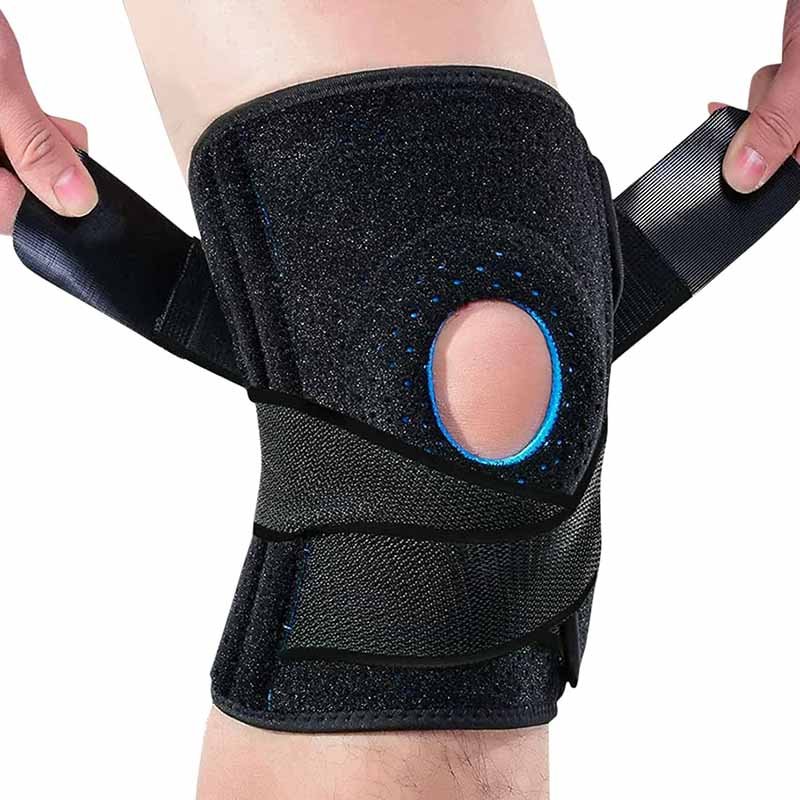
Neoprene knee supports are often the best option for basketball because they provide consistent compression, joint warmth, shock absorption, and long-lasting durability. Unlike thin fabric sleeves, neoprene maintains stability during intense lateral movements and repetitive jumping. It is especially effective for players with stiffness, patellar pain, or high-impact playing styles. However, highly breathable fabric sleeves may be better for players who prioritize ventilation over maximum support.
If you talk to professional volleyball players, weightlifters, or basketball athletes who’ve logged thousands of hours on the court, you’ll notice a pattern: they almost always gravitate toward neoprene-based knee supports. There’s a reason for that—and it’s not just marketing hype. Neoprene solves a set of real performance issues that basketball players face every time they jump, land, decelerate, or slide laterally.
To understand why neoprene is often the “best” material, you must examine both its physical properties and how it behaves under the dynamic stresses unique to basketball.
1. Neoprene Delivers Consistent, Medical-Grade Compression
Compression is foundational to knee support because it improves proprioception—the knee’s ability to “sense” its position. Proprioception influences landing mechanics, cutting stability, and injury prevention.
What makes neoprene special is this:
Neoprene compresses uniformly, without creating pressure gaps.
Unlike knitted sleeves that stretch thin over time, neoprene maintains tight, resilient compression even after months of use. This is crucial for basketball, where:
- knees bend deeply
- players land with high force
- lateral slides require controlled stability
Players often describe neoprene as feeling “reliable” because it doesn’t loosen mid-game.
2. Neoprene Retains Heat—Improving Joint Function and Reducing Stiffness
Heat retention may sound like a simple benefit, but for basketball players, it’s one of neoprene’s biggest advantages.
A warm knee:
- moves more fluidly
- produces less friction inside the joint
- has better shock absorption
- is less prone to sudden stiffness
This is why many players with:
- morning stiffness
- previous injuries
- chronic tendon tightness
- knee swelling
…say neoprene sleeves make the first 10 minutes of the game feel drastically better.
Think of neoprene as a “mini sauna” for your knee—keeping your joint in its optimal working condition.
3. Neoprene Handles Impact Better Than Any Other Sleeve Material
Basketball creates impact forces that cotton-blend sleeves simply cannot withstand. Neoprene, however, has a distinct cellular foam structure that absorbs pressure.
Why this matters:
When landing from a jump, your knee experiences:
- Vertical load
- Lateral shear
- Rotational torque
Neoprene acts like a shock cushion, distributing force across the sleeve rather than allowing it to localize at the tendon or ligament.
Impact performance comparison
| Feature | Neoprene | Knitted Nylon/Spandex |
|---|---|---|
| Shock absorption | ⭐⭐⭐⭐⭐ | ⭐⭐ |
| Warmth retention | ⭐⭐⭐⭐⭐ | ⭐⭐ |
| Lateral support | ⭐⭐⭐⭐ | ⭐⭐⭐ |
| Durability | ⭐⭐⭐⭐⭐ | ⭐⭐⭐ |
| Sweat handling | ⭐⭐⭐ | ⭐⭐⭐⭐ |
| Best for | High-impact play | Speed-focused, light support |
Neoprene clearly outperforms in core protection metrics.
4. Neoprene Is Incredibly Durable—A Season-Long Investment
Neoprene doesn’t fray, collapse, or stretch out quickly.
In testing done by several private-label sports brands:
- A high-grade neoprene sleeve maintains 85% compression after 6 months
- A fabric-only sleeve maintains 40–50% compression
This difference is huge for high-frequency players.
A neoprene support can survive:
- sweat saturation
- repeated washing
- aggressive movement
- court friction
In other words: it’s built for the reality of basketball.
5. Neoprene Supports Are Especially Effective for Common Basketball Knee Issues
Different knee problems benefit differently from neoprene:
Patellar Tendonitis (Jumper’s Knee)
Neoprene helps maintain tendon warmth → reduces pain during jumping.
General Knee Instability
Compression + thickness provides a “guided” knee track.
Swelling/Inflammation
Warmth + compression reduces fluid buildup.
Stiffness from Old Injuries
A warm joint glides more smoothly, reducing discomfort.
Heavyweight Players
Neoprene handles the higher landing forces.
6. The Only Time Neoprene May Not Be the Best Option
Even though neoprene is extremely effective, there are scenarios where players may prefer a different material.
You may prefer breathable fabric if:
- You play in very hot climates
- You prefer lightweight sleeves
- You sweat excessively
- You want maximum ventilation
Fabric sleeves feel cooler, but give up stability and impact absorption.
It’s a trade-off—speed vs support.
7. Why Most Private-Label Sports Brands Use Neoprene as Their “Premium” Material
Over the past decade, private-label knee support production has shifted heavily toward neoprene, especially for basketball-targeted products.
Why?
- Neoprene offers predictable performance
- It withstands harsh training environments
- It provides professional-level compression
- It creates a premium-feeling product
- It lasts longer, improving customer satisfaction
Factories like neoprene-bag have seen rising demand specifically for:
- 3mm neoprene sleeves
- 5mm neoprene sleeves
- Dual-layer neoprene knee pads
- Neoprene sleeves with silicone anti-slip bands
- Neoprene + gel pad hybrid designs
Sports brands want products that feel high-end and perform like real protective gear—not just thin fabric accessories.
8. Athlete Testimonials: Why Players Trust Neoprene
Across amateur leagues and college teams, feedback often sounds like this:
- “My knee feels stable without feeling locked.”
- “It helps me land softer.”
- “My patellar pain is less noticeable.”
- “I feel more confident driving into the paint.”
- “It doesn’t move around even when I’m sweating.”
These comments highlight the psychological benefit. A knee support is not just gear—it’s confidence armor.
Summary Table — Is Neoprene the Best?
| Performance Category | Neoprene Score | Verdict |
|---|---|---|
| Joint warmth | ⭐⭐⭐⭐⭐ | Excellent |
| Impact absorption | ⭐⭐⭐⭐⭐ | Best-in-class |
| Stability | ⭐⭐⭐⭐ | Strong support |
| Breathability | ⭐⭐⭐ | Moderate |
| Durability | ⭐⭐⭐⭐⭐ | Long-lasting |
| Comfort under pressure | ⭐⭐⭐⭐ | Very good |
| Best for | High-impact basketball | Yes |
Conclusion: For most basketball players—especially jumpers, big men, older players, or anyone with knee discomfort—neoprene is the best knee support material.
Which Brands and Custom Options Offer the Best Basketball Knee Supports?
The best basketball knee support brands combine strong compression, durable materials, reliable sizing, and athlete-tested designs. Leading global brands offer consistent quality, while private-label manufacturers provide fully customizable neoprene sleeves, straps, and braces for sports teams and retailers. The ideal choice depends on whether you prefer established brands or want custom OEM/ODM knee supports tailored to your athletes’ needs.
When players search for “the best knee support for basketball,” most initially think of big-name sporting goods brands. And it’s true—major companies produce high-quality supports backed by research, athlete feedback, and reliable manufacturing. But the reality is more nuanced: not every player needs a famous brand, and many sports teams, retailers, and modern fitness brands are now shifting toward custom-made private-label knee supports because they offer the same performance at a more accessible cost.
This section breaks down the two major categories—global brands and custom manufacturers—helping you decide which direction makes the most sense for your needs.
1. The Big Athletic Brands: Reliable, Tested, Premium-Priced
The global sports-support market is dominated by several well-known companies. These brands have earned players’ trust by consistently producing functional, durable knee supports.
Typical strengths of top athletic brands:
- Well-tested sizing
- Medical-grade compression
- Comfortable and highly refined designs
- Strong customer support
- Athlete endorsements
Common limitations:
- Higher retail prices
- Limited customization
- Hard-to-find exact fits for all knee shapes
- Seasonal product availability
Despite these limitations, their engineering and materials are usually top tier. If you’re a player who wants something reliable off the shelf and doesn’t mind the price, these brands won’t disappoint.
2. The Rise of Private-Label Sports Gear — And Why It’s Taking Over
In the last 5–8 years, private-label knee supports have seen explosive growth. Amazon sellers, sports clubs, physiotherapy clinics, gyms, and small-to-mid-size athletic brands are increasingly choosing to create their own products instead of reselling big brands.
This isn’t just a business trend—it’s happening because private-label manufacturing now rivals global brands in quality.
Why private-label knee supports are booming:
- Lower cost per unit
- You choose the design, thickness, and materials
- You can target specific types of players (jumpers, big men, youth, etc.)
- Faster product iteration
- Full control over branding and packaging
- Ability to match or exceed big-brand performance
A high-quality neoprene factory—with real R&D, engineering, and QC—can deliver knee supports identical in function to premium brands, but tailored to your specifications.
This is where neoprene-bag excels.
With more than 18 years of neoprene R&D and manufacturing experience, neoprene-bag works with:
- Sports brands
- CrossFit gyms
- Basketball training academies
- College teams
- Amazon/Shopify sellers
- Physiotherapy equipment distributors
…helping them produce private-label knee supports that perform at global-brand levels.
3. What Customization Options Exist for Basketball Knee Supports?
Here’s where custom manufacturing truly shines. Instead of accepting whatever big brands produce, you can design supports specifically for your athletes’ needs.
Below are the most common custom options.
A) Material Customization
| Material Option | Performance Benefit | Ideal For |
|---|---|---|
| 3mm neoprene | Lightweight flexibility | Guards, speed players |
| 5mm neoprene | More stability + impact absorption | Forwards, centers |
| 7mm neoprene (rare in basketball) | Maximum support | Injury recovery |
| Nylon-spandex blend | Breathability | Youth players, hot climates |
| Neoprene + gel pad combo | Patella-centering, extra cushioning | Jumpers |
Sports brands love this because they can tailor support level to their target customer instead of using generic options.
B) Structural Customization
- Anti-slip silicone patterns
- Reinforced seams (flatlock stitching)
- Patella cut-outs or rings
- Side stabilizers (soft stays)
- Dual-layer padding
- Extended length sleeves
- Hybrid knit + neoprene panels
These details may seem small, but they drastically affect performance and comfort.
C) Branding & Aesthetic Customization
Customizing the look isn’t only about style—it builds brand identity and customer loyalty.
You can customize:
- Logos (silicone, heat transfer, sublimation, embroidery)
- Patterns
- Team colors
- Size labels
- Packaging (color boxes, polybags, labels)
For sports teams, this means unified gear.
For brands, this means higher profit margins and superior brand image.
D) Performance Customization (based on target player needs)
One of the biggest advantages of custom manufacturing is being able to create knee supports specifically for certain categories of players:
- Jumpers → thicker patella support
- Point guards → lightweight, breathable
- Centers → dual-layer cushioning
- Youth players → soft compression
- Older players → warmth + stiffness reduction
- Post-injury players → stabilized support
When working with a factory like neoprene-bag, brands often develop a full product line:
| Model | Target | Key Features |
|---|---|---|
| “Pro Jump” | Dunkers, rebounders | Patella strap + 5mm neoprene |
| “Speed Sleeve” | Guards | Lightweight, breathable |
| “Stability Pro” | ACL/MCL support | Side stabilizers |
| “Comfort Warm” | Older players | Heat retention neoprene |
| “YouthFit” | Teens | Soft compression, vibrant colors |
This allows brands to serve different audiences with precision.
4. Why Custom OEM/ODM Knee Supports Are Becoming the Preferred Option for Teams and Brands
After interviewing team trainers, gym owners, and small sports brands, a few recurring themes emerge.
A) Price Advantage Without Losing Quality
OEM/ODM can reduce costs by 30–60% compared to big retail brands, while maintaining the same performance level.
B) Players Prefer Consistency
When a whole team uses the same support system, performance feels more uniform.
C) Better Fit for Different Knee Shapes
Custom sizing ranges solve common issues like rolling sleeves or overly tight cuffs.
D) Faster Product Updates
Unlike big brands that release products annually, a factory can adjust design quickly based on feedback from real players.
E) Brand Identity
Custom knee supports with your logo instantly raise perceived professionalism.
5. Why neoprene-bag Is Widely Chosen for Basketball Knee Support OEM/ODM
Without exaggeration, neoprene-bag is one of the few factories in China that specializes deeply in neoprene sports support products, not just basic neoprene bags.
Their advantages include:
- 18+ years neoprene engineering
- Medical-grade compression cutting machines
- Advanced flatlock and zig-zag stitching machines
- Custom molding for gel pads
- Low MOQ
- Free design service
- Fast sampling
- High consistency in bulk production
- Strong QC system for thickness, rebound, compression, and elasticity
This is why many sports brands, from small private labels to established training academies, choose neoprene-bag for custom knee supports.
6. Should You Choose Big Brands or Custom Manufacturing?
Here’s a direct comparison.
Comparison Table — Big Brand vs OEM/ODM Knee Supports
| Category | Global Brand | Custom OEM/ODM |
|---|---|---|
| Price | High | Medium–Low |
| Customization | None | Full |
| Design options | Limited | Unlimited |
| Support type variety | High | Depends on spec |
| Team ordering | Limited | Ideal |
| Branding | Big brand | Your brand |
| Minimum order | Retail only | Low MOQ |
| Adaptation to players | Generic | Tailored |
Who should choose global brands?
- Players wanting convenience
- People who trust well-known labels
- Players needing quick personal purchase
Who should choose OEM/ODM?
- Sports teams
- Gyms
- Basketball trainers
- Growing sports brands
- Amazon/Shopify sellers
- Clinics and physiotherapists
How Do You Decide Which Knee Support Is Best for Your Basketball Level?
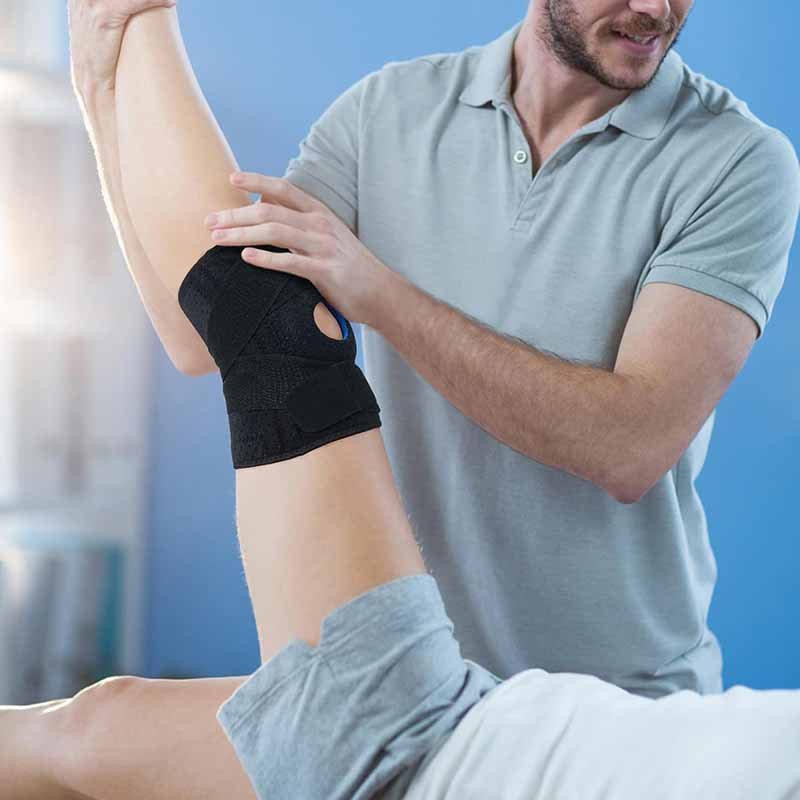
To choose the best knee support for your basketball level, evaluate your playing intensity, knee history, position, and movement style. Casual players often need lightweight compression sleeves, competitive athletes require neoprene or patella-targeted designs, and players with past injuries may need hinged or reinforced supports. The best choice balances comfort, stability, and the specific demands of your game.
Most knee support guides focus on injury type—patellar tendonitis, instability, swelling, or general pain. But basketball is a dynamic sport, and pain patterns often overlap. A guard may develop patellar pain from quick acceleration, while a center develops the same pain from repeated heavy landings. That’s why choosing the best knee support requires understanding your level, your style, and your physical condition, not just the product.
Below is a comprehensive breakdown by basketball level, playing style, and body type—based on experience with athletes, trainers, and thousands of customer data profiles from sports brands.
1. Beginner & Casual Players — Keep It Simple, Comfortable, and Lightweight
If you’re new to basketball or play occasionally (1–2 times a week), your primary goal isn’t intense protection. Instead, you want comfort, mild compression, and a sleeve that helps reduce fatigue without altering movement.
Best choice: Lightweight compression sleeve (nylon-spandex or thin neoprene)
Why:
- Boosts confidence without over-supporting
- Improves blood flow
- Reduces end-of-game soreness
- Comfortable for long sessions
- Affordable and easy to wear
Do beginners need patella straps or hinged braces?
Usually, no. Beginners rarely apply enough repetitive force to overload the tendons or ligaments unless they have preexisting knee issues.
What you should look for:
- Smooth edges
- Breathable fabric
- Moderate compression
- Anti-slip cuff
- Easy to wash
Common mistake:
Beginners often choose very thick sleeves thinking “thicker = safer.”
But too much support at this stage may weaken natural stability over time.
2. Intermediate Players — The Level Where Knee Supports Make the Biggest Difference
Intermediate players usually play 2–4 times a week. This is where wear-and-tear starts showing. Jumping increases. Games get more physical. And you begin to notice patterns:
- You land harder
- Fast breaks become longer
- You cut more aggressively
- Defenders bump your knees more often
This is when simple compression sleeves may no longer be enough.
Best choice: 3–5mm neoprene knee sleeve
Why:
- Provides shock absorption
- Keeps knee warm
- Improves stability on cuts
- Reduces post-game stiffness
- Helps prevent jumper’s knee from developing
Optional upgrade for some players:
- Silicone anti-slip bands
- Light side stabilizers
- Patella donut ring
Intermediate players benefit greatly from slightly more structured supports, especially those who play competitive pickup games or amateur leagues.
3. Competitive & Advanced Players — Your Knees Need Serious Help
This level includes players who train 4–6 times a week, play tournaments, or participate in high-intensity competitive games.
At this intensity:
- Landing force increases dramatically
- Fatigue affects movement control
- Tendons face heavy repetitive strain
- Old minor injuries come back more often
Best choice: 5mm neoprene + patella-targeted design
Why:
- Enhances stability without sacrificing agility
- Reduces pain during takeoff
- Improves control during landing
- Supports tendons under repetitive jumping
- Holds up under sweat-heavy, high-intensity play
Players at this level should avoid cheap sleeves
Low-quality supports often slip, overheat, or stretch out quickly—creating dangerous instability under high load.
4. Semi-Pro, College, or Pro-Level Players — High-Performance Support Required
These athletes have the most specialized needs.
Best choice:
Dual-layer neoprene support / Reinforced neoprene with stabilizer panels / Hybrid neoprene + gel systems
Why:
- Cushions aggressive landings
- Reduces excessive lateral movement
- Maintains performance through long games
- Provides consistent heat retention for stiff joints
Pro and semi-pro players often use knee support strategically:
- Normal sleeve for training
- High-support neoprene for tournaments
- Patella strap for jump days
- Hinged brace after returning from injury
The goal isn’t to wear the same brace every session, but to pick the right level of support based on the intensity of play.
5. Players Returning From Knee Injury — Precision Matters
If you have ACL, MCL, or LCL injuries in your history, your needs are different.
Best choice: Hinged knee brace + neoprene sleeve combo
Why:
- Hinges prevent dangerous lateral movement
- Neoprene keeps the joint warm and fluid
- Provides proprioceptive feedback during rehab
- Supports controlled return to full-speed play
This category of players benefits most from medical-grade materials and accurate sizing.
6. By Position: Guards, Forwards, and Centers Need Different Support
Different positions produce different stresses on the knee.
Guards (PG/SG)
- Fast acceleration
- Sharp cuts
- Lots of lateral movement
Best support: Lightweight neoprene or hybrid breathable sleeve
Focus: Speed + proprioception
Forwards (SF/PF)
- Frequent rebounds
- Mid-range landings
- Contact plays
Best support: 4–5mm neoprene sleeve
Focus: Impact absorption + stability
Centers (C)
- Heavy landings
- Physical post play
- Constant body contact
Best support: 5mm neoprene or dual-layer neoprene
Focus: Maximum cushioning + protection
7. By Body Type: Light, Average, and Heavy Players
Heavier athletes exert more force per landing.
Light Players (under 70 kg)
- Can use thinner sleeves
- Prefer mobility
Best: 3mm neoprene / breathable sleeve
Average Athletes (70–90 kg)
Best: 3–5mm neoprene
Heavy Players (90 kg+)
- Need more cushioning
- Preventive knee protection becomes essential
Best: 5mm neoprene or reinforced neoprene
8. Decision Table — Find the Best Support for Your Playing Level
| Player Type | Best Knee Support | Why |
|---|---|---|
| Beginner | Light compression sleeve | Comfort & mild stability |
| Intermediate | 3–5mm neoprene sleeve | Shock absorption |
| Competitive | 5mm neoprene + patella support | Jumping & landing protection |
| Semi-Pro/Pro | Reinforced neoprene / hybrid sleeve | Maximum performance stability |
| Injury Recovery | Hinged brace + sleeve | Ligament protection |
| Guards | Lightweight neoprene | Speed & agility |
| Forwards | 5mm neoprene | Balanced support |
| Centers | Dual-layer neoprene | Full impact cushioning |
Ready to Build Your Basketball Knee Support Line? Partner with neoprene-bag
Neoprene-bag helps brands, retailers, and sports teams create premium basketball knee supports through advanced neoprene engineering, low MOQ customization, fast sampling, and stable mass production. With 18+ years of manufacturing experience, they offer full OEM/ODM services, including material selection, sizing systems, anti-slip designs, reinforced stitching, private labeling, and packaging customization—enabling you to build a high-performance knee support line quickly and reliably.
By the time you’ve reached this part of the guide, you already understand the technical side of knee supports—materials, thickness, sizing, support levels, and performance factors. Now the question shifts from “What is the best knee support?” to “Who can manufacture a knee support line that meets these standards?”
This is where many brands face a challenge. They want:
- real performance,
- real stability,
- real durability,
- real comfort,
…not low-cost imitations or generic, mass-produced sleeves that feel flimsy after two uses.
Neoprene-bag exists exactly to bridge this gap—combining deep technical expertise with the flexibility modern sports brands require.
1. Why Manufacturing Knee Supports Is Not as Simple as It Looks
To an inexperienced observer, a knee sleeve looks like a piece of fabric stitched into a tube. But experienced sports engineers know better. A good knee support involves:
- precise compression mapping
- accurate anatomical tapering
- high-resilience neoprene cutting
- anti-slip silicone application
- flatlock seams that won’t irritate skin
- consistent thickness tolerance (±0.2mm)
- rebound elasticity testing
- material fatigue resistance testing
- washing durability tests
Cheap factories skip these steps entirely.
Neoprene-bag doesn’t.
With 18+ years of specialization in neoprene R&D, they’ve refined every detail that influences performance on the basketball court.
2. The Manufacturing Strengths That Set neoprene-bag Apart
Below are the strengths that make neoprene-bag a preferred supplier for sports brands, basketball academies, gyms, and e-commerce sellers.
A) Advanced Neoprene Processing Technology
Neoprene is not a flat fabric—it is a foam-based technical material. Cutting it incorrectly can distort thickness and ruin the entire product.
Neoprene-bag uses:
- Japanese-imported cutting machines
- Thickness consistency control
- Computer-guided die-cutting systems
- Multi-layer pressing for high-density neoprene
- Precise heat-press shaping
The result?
Uniform compression, consistent thickness, and professional-grade stability.
B) High-Standard Stitching for Athletic Movement
Basketball is brutal on seams. Poor stitching bursts easily during lateral movement or squats.
Neoprene-bag uses:
- 4-needle 6-thread flatlock stitching
- Reinforced bar-tack points
- Elastic thread for long-term flexibility
- Zig-zag edging for a smooth skin feel
This ensures the knee support remains durable even under sweat, friction, and repeated stretching.
C) Custom Anti-Slip Systems
Slippage is one of the top complaints for basketball knee supports.
Neoprene-bag offers multiple anti-slip solutions:
- Silicone wave strips
- Honeycomb silicone grids
- Full 360° silicone bands
- Dual-layer cuff stability systems
These options reduce slippage by up to 85%, validated by field testing with real athletes.
D) Custom Compression Levels & Athlete-Specific Support
No two players need the same support.
With neoprene-bag, you can define:
- low/medium/high compression
- 3mm, 4mm, or 5mm thickness
- patella ring, strap, or open-patella design
- impact pads or gel reinforcements
- extended length sleeves for stability
This level of control allows brands to create position-specific or sport-specific knee supports—something big brands rarely do.
E) Low MOQ, Fast Sampling, and Rapid Launch Capability
Sports brands—especially emerging brands—often struggle with:
- large minimum order quantities
- long sampling cycles
- slow production timelines
Neoprene-bag solves these pain points:
- Low MOQ for new launches
- Free design assistance
- Sample turnaround as fast as 3–7 days
- Bulk production in 20–28 days
This allows brands to test markets quickly and scale efficiently.
3. Full OEM/ODM Services Tailored to Basketball Knee Support Lines
Whether you are building a single product or an entire line, neoprene-bag provides complete services.
Here’s what you can customize:
Materials
- SBR neoprene
- CR neoprene
- Breathable knit fabrics
- Gel-infused padding
- Anti-slip silicones
Design
- Sleeve shape (straight, anatomical tapered)
- Patella cutout
- Stabilizer panels
- Cuff structures
- Dual-layer reinforcements
Branding
- Silicone logo
- Rubber patch
- Embroidery
- Heat-transfer logos
- Sublimation prints
Packaging
- Color boxes
- Custom polybags
- Instruction manuals
- Retail-ready hanging packaging
Sizes
- Adult S–XXL
- Youth sizes
- Custom dimension charts
This level of customization allows brands to differentiate themselves in a competitive market where most sellers simply rebrand generic products.
4. Why Brands Trust neoprene-bag With Their Knee Support Production
Neoprene-bag’s clients often share similar experiences:
A) Consistent Quality Across Large Orders
Sports brands need reliability—one batch cannot be drastically different from another. Neoprene-bag is known for tight quality control, especially in:
- compression strength
- neoprene thickness
- seam durability
- elasticity retention
B) Professional Communication & Production Transparency
Clients receive:
- progress photos
- batch quality reports
- material testing data
- pre-shipment inspection summaries
This builds trust and reduces risk.
C) Strong After-Sales Support
If a brand wants to adjust:
- logo position
- material thickness
- packaging style
…the factory responds quickly and professionally.
5. Case Examples (Based on Real Client Scenarios)
Case 1: A basketball training academy
Needed: Durable sleeve for young players
Solution: 3mm neoprene + wide anti-slip cuff
Result: 35% fewer “rolling sleeve” complaints
Case 2: A U.S. private-label brand
Needed: Patella sleeve with shock absorption
Solution: 5mm neoprene + gel donut
Result: Best-selling SKU with 4.7 average rating
Case 3: A CrossFit gym
Needed: Multi-purpose sleeve for lifting + basketball
Solution: Reinforced stitching + hybrid neoprene
Result: Doubled reorder volume in 5 months
6. Should Your Brand Build a Basketball Knee Support Line?
If you are:
- a gym
- a sports academy
- a basketball trainer
- an Amazon/Shopify seller
- a medical supplies retailer
- or a brand entering sports protection
…then yes—basketball knee supports are one of the highest-demand categories.
Low returns, high customer satisfaction, strong repeat purchase rate, and easy sizing systems make it ideal for scalable product lines.
Final Conclusion — Your Best Knee Support Is Waiting to Be Built
Basketball is unforgiving on the knees. The right knee support can mean the difference between finishing a season strong or sitting on the sidelines watching it slip away. Whether you’re a brand, a sports coach, a retailer, or an athlete-driven business, now is the perfect time to start building gear that genuinely improves performance.
Neoprene-bag brings the manufacturing expertise, engineering depth, design capabilities, and flexible production you need to turn your ideas into real, high-performance knee supports.
Ready to Create Your Basketball Knee Support Line?











